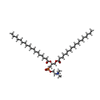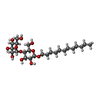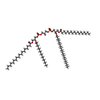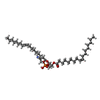+Search query
-Structure paper
| Title | ATP synthase hexamer assemblies shape cristae of Toxoplasma mitochondria. |
|---|---|
| Journal, issue, pages | Nat Commun, Vol. 12, Issue 1, Page 120, Year 2021 |
| Publish date | Jan 5, 2021 |
 Authors Authors | Alexander Mühleip / Rasmus Kock Flygaard / Jana Ovciarikova / Alice Lacombe / Paula Fernandes / Lilach Sheiner / Alexey Amunts /   |
| PubMed Abstract | Mitochondrial ATP synthase plays a key role in inducing membrane curvature to establish cristae. In Apicomplexa causing diseases such as malaria and toxoplasmosis, an unusual cristae morphology has ...Mitochondrial ATP synthase plays a key role in inducing membrane curvature to establish cristae. In Apicomplexa causing diseases such as malaria and toxoplasmosis, an unusual cristae morphology has been observed, but its structural basis is unknown. Here, we report that the apicomplexan ATP synthase assembles into cyclic hexamers, essential to shape their distinct cristae. Cryo-EM was used to determine the structure of the hexamer, which is held together by interactions between parasite-specific subunits in the lumenal region. Overall, we identified 17 apicomplexan-specific subunits, and a minimal and nuclear-encoded subunit-a. The hexamer consists of three dimers with an extensive dimer interface that includes bound cardiolipins and the inhibitor IF. Cryo-ET and subtomogram averaging revealed that hexamers arrange into ~20-megadalton pentagonal pyramids in the curved apical membrane regions. Knockout of the linker protein ATPTG11 resulted in the loss of pentagonal pyramids with concomitant aberrantly shaped cristae. Together, this demonstrates that the unique macromolecular arrangement is critical for the maintenance of cristae morphology in Apicomplexa. |
 External links External links |  Nat Commun / Nat Commun /  PubMed:33402698 / PubMed:33402698 /  PubMed Central PubMed Central |
| Methods | EM (single particle) / EM (subtomogram averaging) |
| Resolution | 2.8 - 34.0 Å |
| Structure data | EMDB-10520: Cryo-EM structure of Toxoplasma gondii mitochondrial ATP synthase dimer, membrane region map EMDB-10521: Cryo-EM structure of Toxoplasma gondii mitochondrial ATP synthase dimer, OSCP/F1/c-ring map EMDB-10522: Cryo-EM structure of Toxoplasma gondii mitochondrial ATP synthase dimer, peripheral stalk map EMDB-10523: Cryo-EM structure of Toxoplasma gondii mitochondrial ATP synthase dimer, rotor-stator map EMDB-10524: Cryo-EM structure of Toxoplasma gondii mitochondrial ATP synthase dimer, consensus map EMDB-10525: Cryo-EM structure of Toxoplasma gondii mitochondrial ATP synthase hexamer, membrane region  EMDB-10526:  EMDB-10527:  EMDB-11403: |
| Chemicals |  ChemComp-PC1:  ChemComp-LMT:  ChemComp-CDL:  ChemComp-PEE:  ChemComp-ATP:  ChemComp-MG:  ChemComp-ADP: |
| Source |
|
 Keywords Keywords |  MEMBRANE PROTEIN / MEMBRANE PROTEIN /  mitochondrial / mitochondrial /  ATP synthase / membrane region / ATP synthase / membrane region /  lipids / F1 / lipids / F1 /  c-ring / peripheral stalk / c-ring / peripheral stalk /  OSCP / rotor / OSCP / rotor /  stator / dimer / stator / dimer /  hexamer hexamer |
 Movie
Movie Controller
Controller Structure viewers
Structure viewers About Yorodumi Papers
About Yorodumi Papers
















